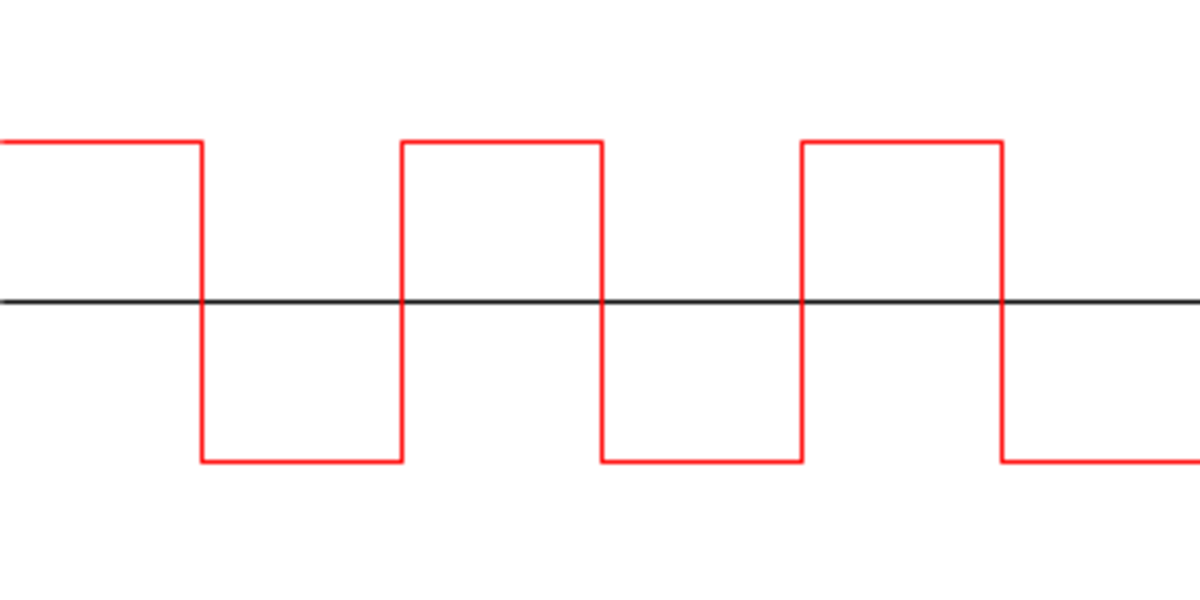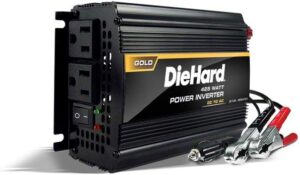You didn’t know you needed one.
Off grid amateurs often forego having an inverter as part of their power capability, most likely because DC powered radio gear doesn’t need one. An inverter also adds expense, and in the case of portable operations, adds weight and space. But inverters bring a lot to the table and add capability to your off grid power plant. Let’s go over the types of AC inverters and bring some clarity to this often overlooked & unappreciated device.
What is an inverter and how does it work?
Briefly, a power inverter is a device that changes direct current (DC) to alternating current (AC). Inverters allow the operation of common 120 volt AC devices from DC or battery power. Obviously, this is very practical and useful to off grid amateurs.
Early inverters worked via analog transistorized oscillators feeding a transformer. The oscillators would take the DC input and alternate it at sixty cycles per second, then the transformer bumps the voltage up to 120 or 240 or how ever many AC volts are needed.
These early inverters were heavy and inefficient. Furthermore, most of them did not produce a “real” AC output. Rather, they created a positive-negative alternating DC square wave. True sine wave inverters, to the extent that they existed, were prohibitively expensive. A compromise design is the “modified square wave” (also referred to as “modified sine wave”) inverter. These inverters produce a voltage that goes positive to negative in stepped increments that roughly mimic an actual sine wave.
Square wave inverters come with serious limitations. Electric motors and transformers in particular do not run well on square wave power because they depend on a true 360 degree sine cycle. If you attempt to run a motor on square wave power, you may notice that it runs slower, hotter, and makes more noise than it would otherwise. Many manufactures of critical electronics, such as medical equipment, explicitly state in product documentation that square wave inverters should never be used to operate their devices.
The technology advances.
Engineers developed the insulated gate bipolar transistor in the early 1980s. IGBTs, are, in essence, switches. Really, really fast switches! This new technology made inverters more efficient and simpler to build. Today, inverters use a network of metal oxide semiconductor field effect transistors (MOSFET), which are descendants of IGBTs. A microprocessor and a series of logic gates control the MOSFETs to create a true sine output. As with most technology, the cost of these devices came down over time. Do you have a switching power supply in your ham shack? Well, a modern inverter is basically a switching power supply running in reverse.
Real life applications.
Now that we’ve had a quick, half-page overview of inverter history and theory of operation, the big question remains: What’s available now, and which kind should you have?
Square wave inverters.. Square wave inverters are obsolete technology. While they are almost impossible to find as new models, used units pop up quite often on eBay and at ham radio swap meets. There is no good reason to use these old inverters unless A) you know for sure it will work for your application, and B) the deal is too good to pass up. Seriously, when you see one for sale, just keep walking even if if the price is really good.
Modified square (or modified sine) wave. These are probably the most popular style of inverter. New and used modified square wave inverters are widely available and are a great “sweet spot” between price and performance. They will work for nearly any application a ham may have. Electric motors, transformers, and similar reactive loads should operate adequately. Essential medical devices may or may not operate safely; consult the product manufacturer for your specific device.
Sine wave. Sometimes referred to as “pure sine wave,” “full sine wave,” or “true sine wave,” no matter what catchy marketing term one sticks on it, they are at the top of the inverter pyramid. With the advancement of technology, the price has come down to levels the average off grid amateur can afford and the output should be cleaner than what you get from the local power company.
Other than price, there are no real downsides to sine wave inverters. For the low-end units the cost difference is not that much between sine wave and modified sine wave. At the mid-to-high end, sine wave versions can be significantly more expensive than their lesser counterparts.
Cheap vs. expensive.
As with most things, you get what you pay for. Avoid places like Walmart and home improvement stores. While you may occasionally find a solid unit there, ninety nine percent of the time they are selling junk. That $89.00 inverter may seem like a great deal, but don’t take the bait!
For a good, modified sine wave inverter with enough capacity to run most devices expect to pay at minimum a few hundred dollars; considerably more for a pure sine wave version. It’s worthwhile to shop sales because there are deals out there. At the time of this writing, Renogy has a really nice 2000 watt sine wave inverter on sale for $30.00 less than an off brand model from Harbor Freight.
Pro tip: Your inverter should be produced by a company that specializes in inverters and power products. For example, Amazon sells DieHard brand inverters. Car enthusiasts may recognize DieHard as a very high quality line of automotive batteries that used to be sold exclusively at Sears. Well, today Sears barely exists and DieHard was auctioned off and watered down to being just an average product sold everywhere. The point is, why buy an inverter from a company that offers them as a sideline to their traditional market segment? It’s like going to the dentist for a pair of glasses. These inverters are very likely not designed & built by DieHard but rather rebranded cheap junk made by some no-name third party.
Samlex, Exceltech, and Renogy specialize in inverters and related power products. There are other good brands but these three are the ones I’ve used and can speak to their integrity. You’ll pay more, but a well chosen inverter will chug along for decades without failing.
So what should you buy?
Forget square wave inverters, even used ones offered for a crazy-good price. If money is a primary concern, go for a modified sine wave inverter. If money is not a primary concern or your equipment must have a stable & accurate AC power source, go for a sine wave inverter. No matter what you buy, buy it from a company that actually makes inverters. Steer well away from brands whose primary focus is not inverters.



As power banks up their battery voltages to +24, +48 and beyond the inverter becomes more important to off-grid operations. Most of these battery banks offer a pretty good capacity (although more costly than a DIY solution), but usually the +12VDC outputs are lacking. This makes some sense because most people are using the 12 V system for typical cigarette lighter purposes, charging and mini appliances.
I use a Ecoflow “solar generator” with 2X200W panels and an optional gasoline generator. The panels are wired in series to produce a nominal 40VDC or so which is fine for the battery input. The generator is also an Ecoflow device and connects via a 48VDC interconnection cable. The battery bank controls the generator, only calling for power when the battery gets below a preset level of charge. I used it to run our club’s digital station over Field Day last year and it worked great, only using about half a tank of fuel overnight.
One thing I did do is get a Generator Noise kit and the HF/VHF noise suppression ferrite rings from Palomar Engineers. Anything that might have come from the power system is completely suppressed (and there wasn’t much to begin with). I also reuse the rings in my car, although I think I get some ignition noise from the antenna in that case. I just made up chokes using a short 3 prong extension cord and a long Powerpole jumper.
One thing to remember, the cheap inverters are more likely to introduce a lot of RFI into your receiver. It’s one more reason to get a good inverter from a reputable manufacturer.
24 and 48 volt inverters are available but you won’t find them at Walmart. They are sold only by off grid & industrial power dealers.
Pingback: Amateur Radio Weekly – Issue 320 • AmateurRadio.com
Hello, I am a ham and own a company that specializes in designing off-grid power systems. Actually, there are several hams that work for us! We primarily use Victron Energy components and I can tell you with certainty that Victron inverters are very, very quiet (from an RFI perspective). Be careful with MPPT controllers, however. You’re far better off using a 48V battery bank, which reduces the current output from the MPPT by 1/4 compared to 12V systems. Doing this will give you an RFI quiet solar charging system as well.
We are currently working with a ham who is building a remote contesting station along the U.K. coast. However, our bread and butter are fixed off-grid systems and commercial mobile systems. One of our customers builds mobile medical clinics with sensitive medical devices, and with the exception of one blood centrifuge that was super sensitive, we have had no issues with RFI or conducted emissions. And that centrifuge was happy once we built a custom a 20kHz filter to remove the PWM switching noise on the output of the Victron inverters. The noise was barely discernible to begin with, but this one device was sensitive to it. Your ham radio station would never notice it 🙂
I run a 5kVA Victron inverter and three MPPT controllers in my personal RV. We use it for Field Day and activating our state’s QSO party. Once I switched over to a 48V system, and was then able to use much smaller MPPTs, I can operate HF with no issues even inside the RV.
I’m not trying to advertise our company. I just wanted to share my professional experience in this space as a ham. Thank you for the interesting article!
With the primary intent of wanting to verify inverter sine wave output I bought this cheapie oscilloscope from Amazon. Without a lot of electronics knowledge & youtube I was able to observe and verify square & modified sine wave inverters vs sine wave. Checked household current 1st as a reference. Maybe the little scope is junk for true electronics purposes (?) but served my purpose well. Currently under $40 & free returns with Amazon prime if it didn’t work. https://www.amazon.com/dp/B0C6XPVLPZ?psc=1&ref=ppx_yo2ov_dt_b_product_details
Hi Rick, oscilloscopes are getting better and cheaper! For a few hundred bucks you can get a scope that is far superior to $30,000 lab grade models from 25 years ago.
I was considering doing an article exclusively about oscilloscopes but have held off since it is something that the average hobbyist does not need. Also, they do take a fair amount of training and skill to get the most out of them. With prices coming down and popularity going up, I may have to reconsider.
Thanks for your comment.